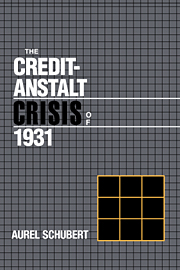Book contents
- Frontmatter
- Contents
- Tables
- Preface
- The Credit-Anstalt Crisis of 1931
- 1 Introduction
- 2 Diary of the crisis
- 3 Financial crisis theories and the Austrian experience of 1931
- 4 The causes of the financial crisis
- 5 The financial crisis and market efficiency
- 6 The financial crisis and economic activity
- 7 The financial crisis and the lender of last resort
- 8 Alternative policies and policy implications
- 9 Conclusions
- Bibliography
- Index
7 - The financial crisis and the lender of last resort
Published online by Cambridge University Press: 20 March 2010
- Frontmatter
- Contents
- Tables
- Preface
- The Credit-Anstalt Crisis of 1931
- 1 Introduction
- 2 Diary of the crisis
- 3 Financial crisis theories and the Austrian experience of 1931
- 4 The causes of the financial crisis
- 5 The financial crisis and market efficiency
- 6 The financial crisis and economic activity
- 7 The financial crisis and the lender of last resort
- 8 Alternative policies and policy implications
- 9 Conclusions
- Bibliography
- Index
Summary
When the market breaks down on occasion, we may need the medicine of a lender of last resort.
–C. P. Kindleberger, 1978The lender of last resort is as common in European financial history as the deus ex machina in Greek tragedy.
–E. März, 1982The domestic lender of last resort
One of the key elements of a financial crisis is that “the whole process [could be] arrested at the outset by a timely intervention of some authority [the lender of last resort] that lends freely at a penalty rate or engages in open market operations” (Bordo 1986a, 191).
The basic function of this lender of last resort is to “stand ready to halt a run out of real and financial assets into money, by making more money available” and thus to prevent a situation such that “each participant in the market, in trying to save himself, helps ruin all” (Kindleberger 1978, 161–2), or in other words, “the financial distress of the few must not be permitted to become a financial crisis for all” (Schwartz 1986, 22).
In Austria, in 1931, the crisis was not arrested at the outset, and a run on its banks and on its foreign reserves occurred, in spite of the quick intervention of the Austrian National Bank and the Austrian government. This suggests that the public had some doubts about the dependability of the arrangements and/or that the authorities were “unschooled” in their response to the bank failure.
- Type
- Chapter
- Information
- The Credit-Anstalt Crisis of 1931 , pp. 141 - 167Publisher: Cambridge University PressPrint publication year: 1992



